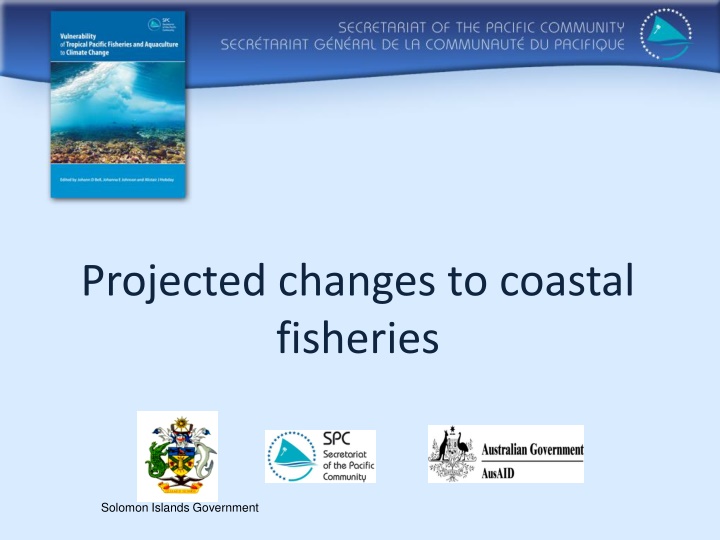
Changes in Coastal Fisheries of the Solomon Islands
This information delves into the projected changes, components, and effects on coastal fisheries in the Solomon Islands, covering demersal fish, nearshore pelagics, invertebrates, and more. It highlights key statistics such as total catch per year and explores the indirect effects of climate change on coral cover, mangrove area, and seagrass area. Additionally, it discusses the impact of habitat degradation on macroalgae, habitat complexity, and coral reef fishes over time.
Download Presentation

Please find below an Image/Link to download the presentation.
The content on the website is provided AS IS for your information and personal use only. It may not be sold, licensed, or shared on other websites without obtaining consent from the author. If you encounter any issues during the download, it is possible that the publisher has removed the file from their server.
You are allowed to download the files provided on this website for personal or commercial use, subject to the condition that they are used lawfully. All files are the property of their respective owners.
The content on the website is provided AS IS for your information and personal use only. It may not be sold, licensed, or shared on other websites without obtaining consent from the author.
E N D
Presentation Transcript
Projected changes to coastal fisheries Solomon Islands Government
Outline Main components of coastal fisheries Indirect effects of climate change Direct effects of climate change Projected changes to coastal fisheries production Priority management measures
Coastal fisheries Solomon Islands 3,250 t/yr Subsistence Commercial 15,000 t/yr
What are coastal fisheries? Demersal fish Nearshore pelagics Invertebrates Species not considered Deepwater snapper Sharks
Coastal fisheries Solomon Islands 3,575 t/yr 8,925 t/yr 5,750 t/yr Total catch = 18,250 t/yr Gillett 2009
Indirect effects of climate change 60 600 50 500 40 400 % coral cover Area (km2) 30 300 20 200 coral cover (%) 10 100 mangrove area (km2) seagrass area (km2) 0 0 now 2035 2050 2100
Effects of habitat degradation Macroalgae 0.5 Proportional change 0 Habitat complexity -0.5 Coral cover -1 0 1 2 3 4 5 6 7 8 9 10 Time after extensive coral loss (years)
Effects of habitat degradation Macroalgae 0.5 Proportional change 0 Habitat complexity Coral reef fishes -0.5 Coral cover -1 0 1 2 3 4 5 6 7 8 9 10 Time after extensive coral loss (years)
Catch composition 60000 50000 Average annual catch (kg/ year) Generalists Not vulnerable 40000 30000 20000 Reef associated Vulnerable 10000 0 Holocentridae Acanthuridae Scaridae Others Mugilidae Lethrinidae Lutjanidae Kyphosidae Labridae Chanidae Siganidae Balistidae Serranidae Carangidae Mullidae Caesionidae Coral associated Highly vulnerable
Catch composition Solomon Islands Percent Catch Availability
Direct effects of climate change 4 8.15 Temperature change 3.5 8.1 pH 3 8.05 Ocean pH 2.5 8 2 7.95 1.5 7.9 1 7.85 0.5 Temperature 0 7.8 now 2035 2050 2100
Effects of temperature 100 90 80 70 Growth (mg/week) Acanthochromis polyacanthus Maximum growth 28-30oC 60 50 40 Projected increase 3oC by 2100 30 20 10 0 22 24 26 28 30 32 34 36 38 Temperature (oC) Zarco Perello and Pratchett 2012
Effects of temperature Declines in: growth lifespan reproduction 100 Fewer & smaller fishes 90 80 70 Growth (mg/week) Maximum growth 28-30oC 60 50 40 Projected increase 3oC by 2100 30 20 10 0 22 24 26 28 30 32 34 36 38 Temperature (oC) Zarco Perello and Pratchett 2012
Effects of temperature Normal spawning temperature 100 90 80 % Dead fish eggs 70 60 50 40 30 20 10 0 27.9 29.5 32.0 32.8 33.9 34.7 Temperature (oC)
Effects of ocean acidification Abalone 80 20 deg C 22 deg C 24 deg C 70 60 % larval survival 50 40 30 20 10 0 pH 8.2 pH 7.8 pH 7.6 Byrne 2012
Effects of ocean acidification Munday et al 2012
Projected coastal fisheries production Solomon Islands % Fisheries 2035 2050 2100 Main effects catch Habitat loss and degradation Changes in distribution of tuna -2 to -5% -20 to -50% Demersal fish 50 -20% Nearshore pelagic fish -15 to -20% 31 0% -10% 0 to -5% -5 to -10% -10 to -20% Ocean acidification Invertebrates 19
Priority management measures 1. Protect structural complexity and biological diversity of coral reefs, mangroves and seagrass to sustain fisheries and maximise adaptation potential 2. Recognise ecological importance of herbivorous fish and ensure stocks are sufficient to maintain ecosystem functions 3. Maintain adequate spawning stocks of all species to help overcome the shocks of greater climate extremes
Conclusions Coastal fisheries are critically important for both food security and livelihoods Effects of climate change will add to existing pressures (e.g. overfishing) Improved catch data are needed for monitoring effects of climate change on coastal fisheries: separate data for each main category of coastal fisheries subsistence fisheries catches
Thank you j.johnson@c2o.net.au
